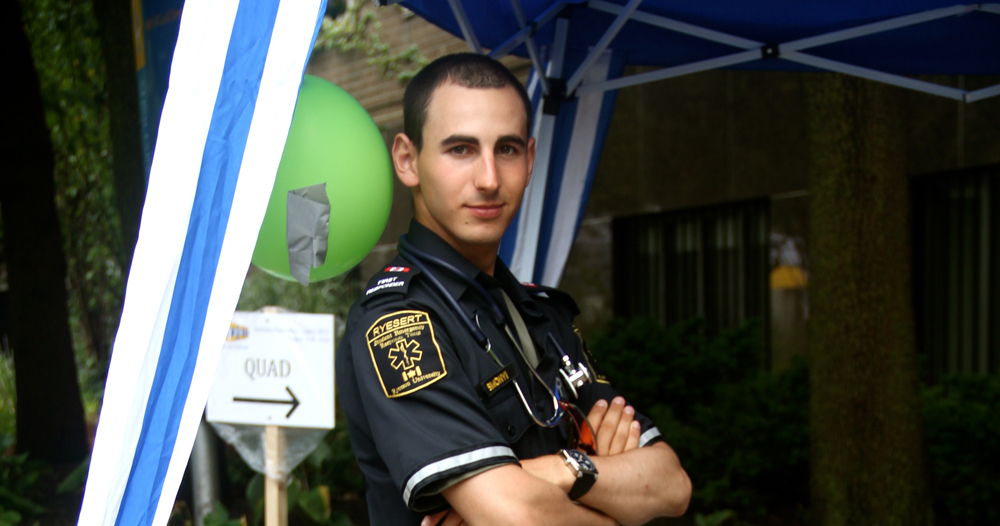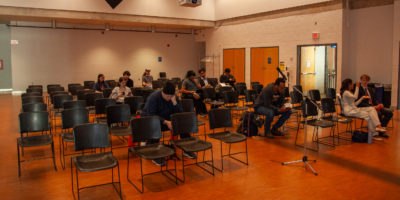With a increase in volunteers since the beginning of the school year, RyeSERT is attempting to lengthen the time they spend on-call in Pitman Hall. David Owen explores the life of a training officer and how the group came to be what it is today
As he lays down his head to fall asleep, the walkie-talkie beside his bed crackles to life and Stefan Simonyi springs out of his bed without hesitation. After completing a quick check of his supplies and fastening a 20 pound equipment bag to his back, Simonyi rushes out of Pitman Hall room 202 and replies to the call, “Copy Delta One. RyeSERT on route.” Within minutes, Simonyi will be at the scene of an injury, executing any number of non-invasive medical procedures ranging from recording their vitals to performing CPR.
Along with Ryerson security and emergency services staff, Simonyi is responsible for calling an ambulance and relaying his findings to paramedics upon their arrival, with no room for panic.
“Keeping a cool head is the most important thing to remember,” he says. No matter how late it may be, once the silence in RyeSERT (Ryerson Student Emergency Response Team) headquarters is broken by the call on his transmitter, Simonyi is alert – someone in residence is in need of assistance.
RyeSERT is a student group that provides basic medical care to oncampus residents, a dedicated group of student volunteers from a variety of programs who sign up for on-call shifts each week from Thursday to Sunday. All volunteers must complete Standard First Aid and CPR C courses (the level of course taken by police officers, fire fighters, first responders, workplace First Aid teams and lifeguards) as well as the RyeSERT on-call training program.
Collectively, members are required to complete 19 hours of training in addition to updated medical instruction every few months.
Simonyi, a second-year arts and contemporary studies student, has worked with RyeSERT since his first year. He joined the group on a friend’s recommendation and is now the Training Officer, which is great experience along his path to become a paramedic.
Simonyi says that the group has grown by recruiting at student fairs and orientation events. “The expansion benefits everyone in the community,” Simonyi says. “When the group was smaller, the executive team had to cover shifts when the time slots weren’t filled. We were all exhausted from always being oncall.” The group started the fall semester with fewer than 20 members, but thanks to campaigning at the beginning of the year, their numbers have risen to 67 student volunteers.
While volunteers for the program are on duty, they reside on the second floor of Pitman Hall in a room that contains a bunk bed, desk, and all of the RyeSERT equipment.
“You can get your work done, but when you’re on-call that’s the first thing on your mind,” says Simonyi.
Students can work overnight shifts alone, but often work in pairs.
While they are helping injured residents, they spend their time completing schoolwork, watching movies, or sleeping – with their walkietalkie on full volume, of course.
Once a resident dials “80” from any internal phone, the Ryerson security team receives the call and dispatches RyeSERT. Simonyi recalls a time when there weren’t enough volunteers to fill the weekend’s schedule, so he remained on-call for 72 consecutive hours, most of it alone.
After RyeSERT receives the message, the on-duty volunteers accompany security to the scene and it is up to them to determine whether calling an ambulance is an appropriate next step. RyeSERT does not perform invasive medical treatments and, unlike campus security, members are not permitted to administer oxygen because the group is not affiliated with a doctor. \
“We have a great relationship with the security staff,” Simonyi says. “They seem happy to have us around and they do what they can to assist our new members.”
So far this semester, RyeSERT has responded to six calls, none of which required hospital treatment. The first call was an incident in which a resident stubbed their.
“Most of the calls we receive are non-emergencies. It’s still a good idea to call us so the student can know their injury will be handled properly,” Simonyi says, as he scans the thorough reports that are filled out during and after each incident.
He says they receive most calls on Saturday nights. “Many incidents are alcohol-related. We are assisting students in residence after all,” he says. “Most of the time they just need an ice pack.” After hundreds of hours on duty, Simonyi has never been called to the scene of a life-threatening injury.
However, RyeSERT is striving to implement a 24/7 on-call system to handle potential incidents that occur throughout the week. “Injuries can happen anytime and with more volunteers, we may be able to extend our hours,” he says, noting that serious injuries, such as anaphylactic shock, can happen at any time.
The group does not plan to stop there. RyeSERT’s executive team is seeking to do more this year outside of headquarters in order to educate students and increase awareness about their group’s work on campus.
“We’re moving fast this year,” Simonyi says. “There’s a lot on the table.” The team is also working on establishing a partnership with St. John Ambulance, a Canadian organization that instructs classes on first aid and CPR.
RyeSERT is funded by the Project Funds Allocation Committee for Students (P-FACS). Since RyeSERT is considered a student group rather than a university service, the team receives $5,000 annually, but Simonyi does not think this is enough.
The biggest expense is uniforms, as it is important to wear blood and pathogen-resistant clothing while in close contact with anyone who has been injured.
“We want to hire a professional to train our volunteers and ensure a consistent level of care, but EMR (Emergency Medical Responder) courses cost $1,000 per student,” Simonyi says. The additional training would extend the types of treatment RyeSERT is able to provide, so the team is planning ways to secure this opportunity for volunteers.
Simonyi says that training is a significant part of their role with the university. In addition to performing pre-hospital treatment to injured students, RyeSERT offers Standard First Aid and CPR C courses at a lower rate. The focus is to instruct any member of the Ryerson Community on how to perform useful life skills as well as the ability to exercise a level or preparedness in an emergency situation. Alex Best, outgoing director of RyeSERT, leads classes on weekends, though the next session date has not yet been determined.
Learning these skills has given Simonyi the ability to help family and friends in case of an emergency.
“Just recently, I had to step up to the plate and hand off my mom’s vitals to paramedics when she was feeling symptoms of a heart attack,” Simonyi says.
Not long before that incident, he was exiting a subway train when he saw an elderly woman get hit by a closing door and fall on her hip.
While waiting for an ambulance to arrive, Simonyi conducted a scene survey, identified himself and asked permission to assist her, then began to check her levels of consciousness.
From his training and experience with RyeSERT, he knew the correct questions to ask the injured woman and how to support her until the ambulance arrived, at which point Simonyi relayed his findings to a paramedic.
Any full time Ryerson student or member of the Ryerson Students’ Union is eligible to apply. RyeSERT is currently looking for an equipment officer to join the executive team, and positions are always open for “inoperative” members, who assist with administration and events but do not work on-call.










Leave a Reply